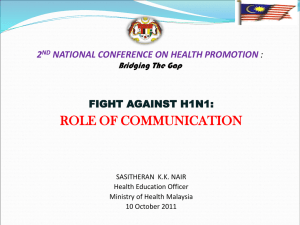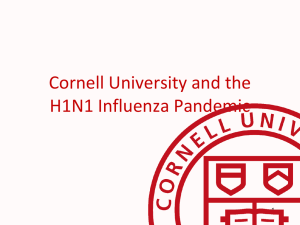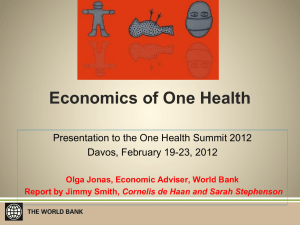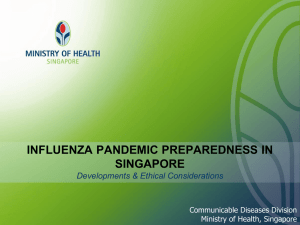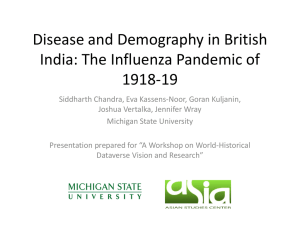University of Colorado Denver Pandemic Preparedness and
advertisement
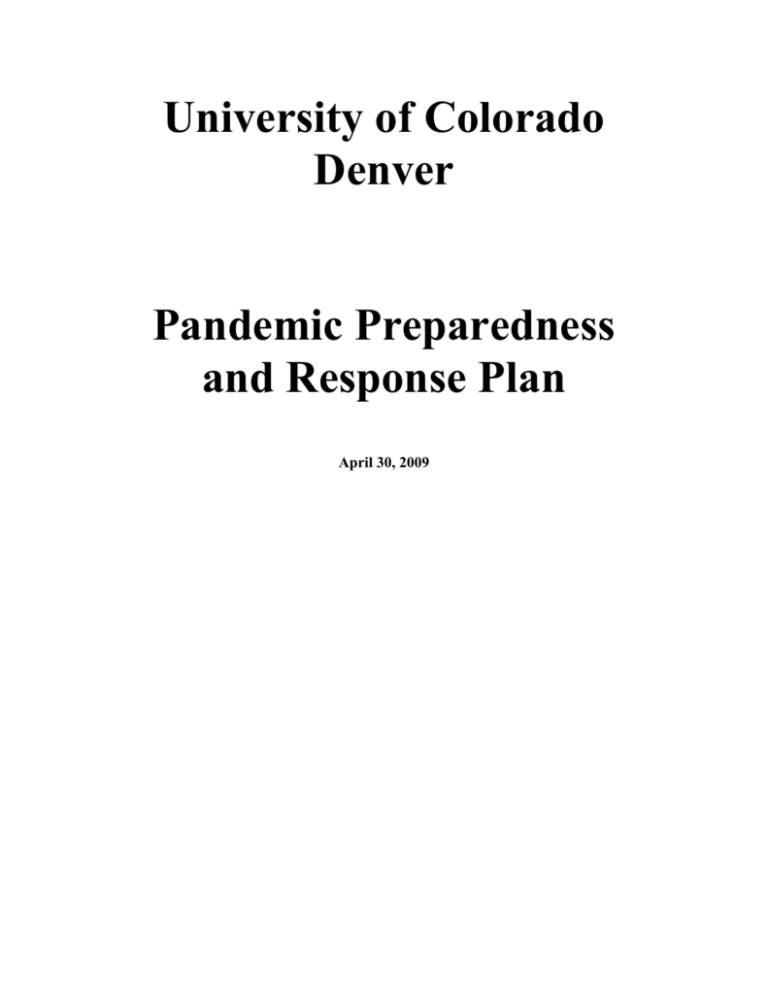
University of Colorado Denver Pandemic Preparedness and Response Plan April 30, 2009 UCD Pandemic Preparedness and Response Plan Executive Summary The World Health Organization (WHO) and the Centers for Disease Control and Prevention (CDC) have warned that there is a high risk that a influenza virus could mutate into a form that triggers the next human influenza pandemic. Many health experts throughout the world believe that the Swine H1N1 virus or Avian H5N1 virus has a strong potential to become a global pandemic. However, it is important to note that the both the H1N1 or H5N1 viruses could disappear and a new virus could emerge at any time to cause a pandemic. Because most natural and human-made disasters tend to be limited to a specific area, Continuity of Operations and emergency response plans have typically placed more focus on damage to property, equipment, and machinery; business interruption; and limited loss of personnel. An especially severe influenza or other pandemic could do just the opposite - lead to high levels of illness or death while minimally affecting physical property. Most experts believe a pandemic will have a world-wide impact that will be rapid and unpredictable, arriving in multiple waves and spreading quickly from one region to another. Because pandemics spread rapidly, once a pandemic virus emerges it is too late to begin planning or collaboration efforts. The University of Colorado Denver (UCD) must plan and develop a response in order to maintain essential services that will allow continuity of its important and vital missions of education, research and provision of healthcare. Most experts believe that these waves of illness will disrupt everyday life. An especially severe pandemic could lead to high levels of illness, death, social disruption, and economic loss. Impacts could range from school and business closings to the interruption of basic services such as public transportation and food delivery. The most important pandemic issues facing the UC Denver campus will be controlling infection; protecting the health of students, faculty, staff and researchers and their families; coping with the impacts of absenteeism and managing supply disruptions. This Pandemic Preparedness and Response Plan establishes the planning factors and requirements necessary for every Department’s Continuity of Operations Plan. These planning factors establish a common planning perspective that will allow University leaders to prepare independent but mutually supporting plans for a coordinated and effective response to the pandemic flu. Modifications, improvements and enhancements to this document will be transmitted to the campus as they become available and posted at http://www.uchsc.edu/police/EmergencyPreparedness/EmergencyPreparedness.php Questions, comments, and recommendations should be directed to Stuart Pike, Emergency Preparedness Coordinator, stuart.pike@uchsc.edu, (303) 724-0148. UCD Pandemic Preparedness and Response Plan – 11/20/2006, Revised 4/30/09 UCDHSC Pandemic Response Plan Background An influenza pandemic occurs when a new influenza virus emerges for which people have little or no immunity and for which there is no vaccine. The disease spreads easily from person to person, causes serious illness, and can sweep across the country and around the world in very short time. There are three distinct forms of influenza, and they should not be referred to interchangeably: Seasonal (or Common) Flu is a respiratory illness that can be transmitted from person to person. Most people have some immunity, and a vaccine is usually available. (Each year, a new vaccine must be made to match the predominant strain.) Swine Flu is caused by influenza viruses that occur naturally among pigs. The H1N1 variant is a respiratory disease of pigs that like all viruses’ changes constantly. New viruses that are a mix of swine, human and/or avian influenza can emerge. Avian (or Bird) Flu is caused by influenza viruses that occur naturally among wild birds. The H5N1 variant is deadly to domestic fowl and can be transmitted from birds to humans. There is no human immunity and no vaccine is available. Pandemic Flu is virulent human flu that causes a global outbreak (or one in a wide geographic area) of serious illness. Because there is little natural immunity, the disease can spread easily from person to person. Pandemic viruses emerge due to a sudden change in the virus caused by changes in the protein coat on the surface of the virus. These changes can either make the virus less virulent or increase its virulence. Viruses mutate in order to adapt. It is the nature of a virus to survive, and mutating is a virus’ defense mechanism. There were three acknowledged pandemics in the 20th century: 1918-19 Spanish Flu (H1N1). This flu is estimated to have sickened 20-40% of the world’s population, and approximately 50 million people died. Between September 1918 and April 1919, 600,000 Americans died. It spread rapidly; many died within a few days of infection, others from secondary complications. The attack rate and mortality was highest among young adults, although the reasons for this are uncertain. 1957-58 Asian Flu (H2N2). This virus was quickly identified due to advances in technology, and a vaccine was produced. Infection rates were highest among school children, young adults, and pregnant women. The elderly had the highest rates of death. A second wave developed in 1958. In total, there were about 70,000 deaths in the United States. UCDHSC Pandemic Response Plan 1968-69 Hong Kong Flu (H3N2). This strain caused approximately 34,000 deaths in the U.S. This virus was first detected in Hong Kong in early 1968 and spread to the United States later that year. Those over age 65 were most likely to die. This virus returned in 1970 and 1972 and still circulates today. Most experts agree that it is not a question of whether there will be a pandemic, but when it will occur. The severity of the next pandemic cannot be predicted. However, some models suggest that the impact of a severe pandemic on the U.S. in the absence of any control measures (covering coughs and sneezes, washing hands, and using vaccines or anti-viral drug therapies) could include illness in 30% of the population, hospitalization of as many as 10 million people, and almost two million deaths. The estimated economic impact could be $71.3 to $166.5 billion, excluding disruptions to commerce and society. Additional information available at the CDPHE Emergency Preparedness and Response site http://www.cdphe.state.co.us/epr/planning.html. The CDPHE’s Pandemic Influenza Summary can be downloaded at http://www.cdphe.state.co.us/epr/pandemic.html. Information for this section was adapted from http://www.pandemicflu.gov/general http://www.who.int/en/ http://www.cdc.gov/swineflu/ Strategy This plan provides the necessary information for each Department to update its Continuity of Operations Plan to address the unique requirements of preparing for, and responding to, a pandemic. It is expected that each Department will incorporate the information contained in this plan in its Continuity of Operations Plan. The UC Denver Emergency Response Coordinator, along with the Communicable Disease Subcommittee will continuously monitor the pandemic threat and revise this plan as necessary. The strategy recognizes the following key elements: The effects of a pandemic on our faculty, staff, students, parents, visitors, and community. The need for broad and inclusive communications—both internally and externally. The steps necessary to implement appropriate and adequate preparations to include training and exercises. The coordination required to plan effective preparedness, response and recovery actions. UCDHSC Pandemic Response Plan This plan outlines the structure to plan for and manage response to a contagious disease outbreak of significant magnitude. Should a pandemic occur, it will be the responsibility of public health departments at the county and state levels to implement the most appropriate, community-based control measures, including issuing isolation and quarantine orders and closing down large gatherings (e.g., events or schools). The UC Denver administration reserves the right to initiate more restrictive actions independently. More restrictive control measures may be taken in support of University’s Continuity of Operations Plan and the long-term health of the institution and its faculty, staff and student’s health. UC Denver will work closely with the Tri-County Health Department and will comply with all directives that seek to limit the spread of the pandemic. Objectives Pandemic Flu planning is an effort to assure that the capability exists to continue essential functions in a pandemic environment. The objectives of this COOP plan include: Ensuring the continuous performance of the University’s essential functions/operations during a pandemic; Protecting essential facilities, equipment, records, and other assets; Reducing or mitigating disruptions to operations; Reducing loss of life, minimizing damage and losses; and, Achieving a timely and orderly recovery from an emergency and resumption of full service to faculty, staff, students, researchers and the community. Assumptions The first human cases will likely occur in other countries and will be detected by the global surveillance network. However, given the substantial international travel by our faculty, it is possible that our campus could host one of the first cases of Avian Influenza or a pandemic disease in North America. Planning is an essential component of pandemic influenza preparedness. It is too late to begin planning at the onset of a pandemic. Experts anticipate that an influenza pandemic could last from 6 to 12 months, with at least two waves of illness in that time. Each wave could last from three to eight weeks. There will be universal susceptibility to the pandemic influenza subtype. Vaccinations and antiviral treatment are anticipated to be the most effective medical treatments, but they may be nonexistent or in limited supply. Risk groups for severe and fatal infections cannot be predicted with certainty. UCDHSC Pandemic Response Plan The typical incubation period for respiratory influenza will be two days. Persons who become infected may shed virus and can transmit infection for one to several days before the onset of illness. Viral shedding and the risk for transmission will be greatest during the first two days of illness Non-medical containment measures based on current epidemiological knowledge of influenza will be the principal means of disease control until vaccinations are available, but decisions about non-medical containment measures will be made in an atmosphere of considerable uncertainty. The seasonality of a pandemic cannot be predicted with certainty. The largest “waves” in the U.S. during 20th century pandemics occurred in the fall and winter. Continuity of Operations Planning Factors Departments on campus will have Continuity of Operations Plans that includes plans for operating with 40% absenteeism. Continuity of Operations Plans must identify essential job functions and essential services personnel that will need to continue to work even if campus is closed. Continuity of Operations Plans should address viable communications plans to keep departmental leadership informed of the status of the department’s activities and its members. Continuity of Operations Plans should address cross-training of certain critical job classes to allow temporary replacement of sick workers if needed. Continuity of Operations Plans should support telecommuting and other social distancing plans, including developing protocols that determine when to allow telecommuting and other work options. Departments should be prepared to operate up to 8 weeks in an influenza pandemic environment. Review definition of essential employees to ensure the appropriate people are designated to maintain your department’s essential functions for a period that could last up to 8 weeks. Direction and Control The University of Colorado at Denver and Health Sciences Center will retain direction and responsibility for its own operations, personnel, resources, and facilities. The line of succession for Continuity of Operations is as follows: o Chancellor UCDHSC Pandemic Response Plan o o VC of Finance & Administration Vice Chancellors The Vice Chancellor, Dean, Director, or head of each Department involved in the execution of this plan is responsible for the pandemic flu response preparation and operations of his/her department or department. When necessary, the campus Emergency Operations Center (EOC) will be activated. Vice Chancellors, Deans, Directors, and Department Heads Units need to address the following issues when developing Continuity of Operations plans: Identify essential functions that must be maintained during a pandemic and identify who will perform those functions. Complete an inventory of all supplies and equipment identified as essential to ongoing business functions and ensure a process is in place to maintain adequate inventory in the event of a pandemic. Coordinate the training necessary to support your plans. Conduct exercises to evaluate your plans. Assisting Agencies’ Responsibilities Tri-County Public Health Tri-County Public Health will continue to support and offer guidance concerning campus efforts to manage disease outbreak and control. It will inform the University of any quarantine or other public health actions and requirements. It will also inform the campus of actions by the Colorado Department of Public Health and Environment regarding disease outbreak. State Division of Emergency Management/Colorado Department of Public Health and Environment The state Emergency Operations Center may provide additional information, services, or guidance. The state may also require reports or information.

